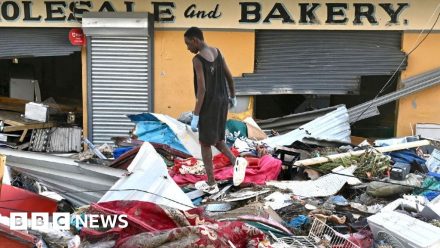More than 1 million people were evacuated across the Philippines and at least two people were killed as Typhoon Fung-wong, the second major storm to strike in days, made landfall on the east coast. The super-typhoon crossed the north of Luzon, the country’s most populous island, bringing torrential rain, sustained winds of 115 mph (185 km/h) and gusts up to 140 mph (225 km/h).
The storm follows days after Typhoon Kalmaegi, which killed at least 224 people and left 135 missing; searches for those missing were suspended on safety grounds. Before Fung-wong’s landfall, authorities reported two deaths: one person drowned in Catanduanes and a 64-year-old woman was found under debris after a home collapsed in Catbalogan City. A rescuer in Catbalogan said the woman had gone back into her house, possibly to retrieve something, and was trapped as the wind and rain intensified.
Forecasters warned Fung-wong could bring a vast rain and wind band spanning as much as two-thirds of the archipelago, with a 1,118-mile-wide reach. In the Philippines, tropical cyclones with sustained winds of 115 mph or higher are classified as super-typhoons to underscore the heightened danger. Scientists say human-driven climate change is making storms stronger: warmer seas fuel rapid intensification and a warmer atmosphere holds more moisture, producing heavier rainfall.
Civil defence officials said about 1.2 million people were pre-emptively evacuated. Government meteorologists expected at least 200 mm (8 in) of rain in many areas. Fung-wong was the 21st significant storm to hit the country this year, stretching disaster response capacity.
The storm struck Dinalungan town in Aurora province on Sunday night after battering north-eastern provinces from offshore. In Aurora, residents boarded up homes with steel sheets and wooden boards before darkness fell, fearing the added danger of a night-time landfall. Schools and government offices across Luzon, including Manila, were ordered closed on Monday; nearly 300 flights were cancelled.
Defence secretary Gilberto Teodoro urged compliance with evacuation orders, warning that refusing to evacuate could endanger rescue personnel. Officials in Catanduanes reported storm surges, submerged houses up to the roofs, and waves sweeping over streets. In Virac, a local said waves roaring against the seawall made the ground feel like it was shaking. Verified video from Guinobatan in Albay showed streets turned into raging torrents.
Rescue teams evacuated residents in affected provinces, and government broadcasters shared footage of widespread flooding and near-zero visibility due to intense rain and wind. Pope Francis offered prayers for the mostly Catholic nation, expressing closeness to those affected and praying for the deceased, injured and displaced.
Fung-wong was forecast to move north of the Philippines, remain a typhoon as it reached coastal waters on Monday morning, then head out to sea and weaken as it approached western Taiwan later in the week.
Agence France-Presse and Reuters contributed to this report.






